| |
RIVER KINGFISHERS Alcedininae |
- 24 species in the Old World tropics
- DR personal total: 16 species (67%), 9 photo'd
|
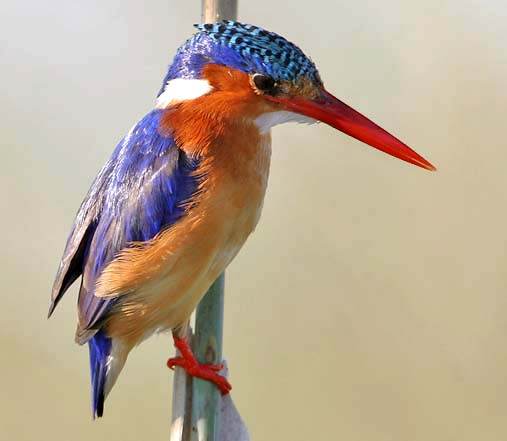 The
Alcedininae, or River Kingfishers, are all small birds. They are the
most ancient of the three kingfisher lineages (Moyle 2006). Some
species in this group — in the genus Alcedo, like the very widespread Common Kingfisher A. atthis
— do fish regularly along streams and rivers. But many of the two dozen
species in this group are forest birds, although quite a few prefer the
edges of small wooded rivulets. The
Alcedininae, or River Kingfishers, are all small birds. They are the
most ancient of the three kingfisher lineages (Moyle 2006). Some
species in this group — in the genus Alcedo, like the very widespread Common Kingfisher A. atthis
— do fish regularly along streams and rivers. But many of the two dozen
species in this group are forest birds, although quite a few prefer the
edges of small wooded rivulets.
All members of this group are colorful, like this Malachite Kingfisher
(left), a widespread species in sub-Saharan Africa. Most have patterns
of dark blue, often contrasting with shining paler blue, and shades of
rufous or orange. When one gets close views of any of them, like this African Pygmy-Kingfisher (below) that was netted and photographed by Dale & Marian Zimmerman, the glittering colors can be astonishing.
|
|
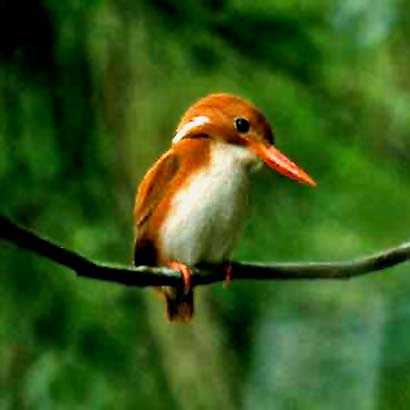 Woodall (2001) placed all 24 species in just two genera — Ceyx and Alcedo
— but these have not proved to be monophyletic groups. Marks &
Willard (2005) recognized at least 4 genera on molecular evidence.
Consider, for example, Madagascar Pygmy-Kingfisher
(right). This tiny beauty is only 7 inches (13 cm) long, and hunts for
frogs and insects from a low branch in the dense understory. Because of
its rufous color and bill shape, it had been thought to be linked to
dwarf kingfishers in southeast Asia [genus Ceyx] but genetically it is closer to the African species of dwarf kingfisher, which should be placed in the genus Corythornis.
These data suggest the certain behaviors and plumage types evolved
separately several times in the Alcedininae (Marks & Willard 2005,
Moyle et al. 2007). Woodall (2001) placed all 24 species in just two genera — Ceyx and Alcedo
— but these have not proved to be monophyletic groups. Marks &
Willard (2005) recognized at least 4 genera on molecular evidence.
Consider, for example, Madagascar Pygmy-Kingfisher
(right). This tiny beauty is only 7 inches (13 cm) long, and hunts for
frogs and insects from a low branch in the dense understory. Because of
its rufous color and bill shape, it had been thought to be linked to
dwarf kingfishers in southeast Asia [genus Ceyx] but genetically it is closer to the African species of dwarf kingfisher, which should be placed in the genus Corythornis.
These data suggest the certain behaviors and plumage types evolved
separately several times in the Alcedininae (Marks & Willard 2005,
Moyle et al. 2007).
Taxonomy has been controversial
in some species. For example, Woodall (2001) splits populations on Sao
Tome and another on Príncipe as island endemics, while other
authors (e.g., Dickinson 2003) do not. There is the further problem of
the very tiny Ceyx kingfishers of the Malay Peninsula and
Greater Sundas. On the mainland there are black-backed and
rufous-backed forms that generally behave as separate species (one
partially migratory; one resident) but on Borneo the two types widely
interbreed. Every one we saw in Sabah in summer 2003 had
characteristics of both types: usually rufous backs with blackish wings
and intermediate facial patterns. It makes sense to me that Woodall
(2001) considers them a single species: Oriental Dwarf-Kingfisher Ceyx erithacus. |
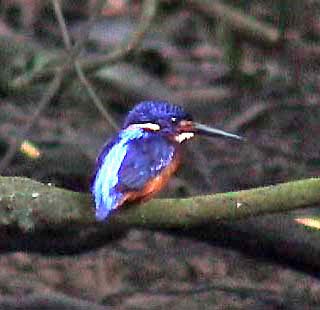 Seven
of the group have names like "pygmy-kingfisher" or "dwarf-kingfisher."
Almost all of these tiny kingfishers hunt fish and amphibians along
forested streams where dense thickets make viewing difficult. Despite
their bright colors, most of the alcedine kingfishers are quite hard to
see. The Blue-eared Kingfisher (left, in a video
capture by Rita Carratello) is usually just barely glimpsed as a jolt
of bright blue disappearing through the roots of riverside vegetation
in of s. Asia or the Greater Sundas. Seven
of the group have names like "pygmy-kingfisher" or "dwarf-kingfisher."
Almost all of these tiny kingfishers hunt fish and amphibians along
forested streams where dense thickets make viewing difficult. Despite
their bright colors, most of the alcedine kingfishers are quite hard to
see. The Blue-eared Kingfisher (left, in a video
capture by Rita Carratello) is usually just barely glimpsed as a jolt
of bright blue disappearing through the roots of riverside vegetation
in of s. Asia or the Greater Sundas.
According to the phylogeny suggested by Marks & Willard (2005), Blue-eared Kingfisher is one of the "real" Alcedo kingfishers, along with Common Kingfisher A. atthis and Shining-blue Kingfisher A. meninting. Most of the others should be moved to Ceyx or the newly revived African genus Corythornis. Under this arrangement, the Alcedo kingfishers are widespread in African and Eurasia, but Ceyx becomes a genus of tropical Asian and Australasian species. |
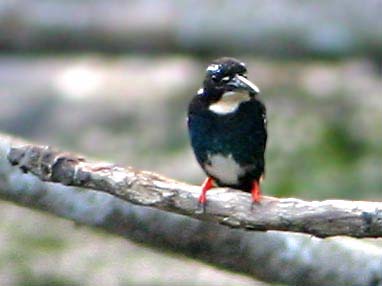 Some species of Ceyx kingfishers are endemics on islands in the western Pacific, including Silvery Kingfisher (right) of the Philippines. Other endemics occur on Sulawesi and the Bismark Archipelago, with one species — Azure Kingfisher Ceyx azurea — ranging as far as New Guinea and Australia. Some of them, including Silvery Kingfisher, are scare and local. Some species of Ceyx kingfishers are endemics on islands in the western Pacific, including Silvery Kingfisher (right) of the Philippines. Other endemics occur on Sulawesi and the Bismark Archipelago, with one species — Azure Kingfisher Ceyx azurea — ranging as far as New Guinea and Australia. Some of them, including Silvery Kingfisher, are scare and local.
The River Kingfishers can be thought of as the pygmy/dwarf kingfishers of the Old World. |
Photos: The Malachite Kingfisher Corythornis cristata was in the Okavango Delta of Botswana in July 2005. Dale & Marian Zimmerman netted and photographed the African Pygmy-Kingfisher Corythornis picta way back in Aug 1963 along the Mara River, Kenya. The Madagascar Pygmy-Kingfisher Corythornis madagascariensis was in a ravine near Lake Ampijoroa, Madagascar, in Nov 1992. Rita Carratello videoed the Blue-eared Kingfisher Alcedo meninting along a tributary of the Kinabatangan River, Sabah, Malaysia, in north Borneo, on 1 Aug 2003. The Silvery Kingfisher Ceyx argentata was in the PICOP forest of Mindanao on 26 Dec 2005. All photos © Don Roberson, except those attributed to Dale & Marian Zimmerman, and Rita Carratello, and used with permission; all right reserved.
Bibliographic note:
Family book: 
Fry, C. Hilary, Kathie Fry, and Alan Harris. 1992. Kingfishers, Bee-eaters & Rollers. Princeton Univ. Press, Princeton, N.J.
Hilary Fry is well-known as a co-author of the fabulous Birds of Africa
handbook series. He has also done a lot of research on bee-eaters and,
to a lesser extent, kingfishers. His earlier family book on Bee-eaters
(1984) in the Poyser series was well received. This volume, written a
dozen years later, is expanded to cover the kingfishers and rollers,
but Fry's forte remains the bee-eaters. I found the bee-eater text much
better than the kingfisher text. On the other hand, Alan Harris — the
artist for this 1992 book — does a fine job with this colorful family,
and thus this is a very attractive book. Leafing through the plates is
a great treat [like all the family books in these series, the plates
are grouped together in the front, with the text following].
Fry's species-level taxonomy is rather conservative, especially these
days. He includes only 87 species of kingfishers while Woodall (2001)
has 92 species. I think the latter is nearer the mark given current
trends. Fry, Fry & Harris follow the Sibley & Ahlquist (1990)
taxonomy at the family level, and thus discuss three separate families
of kingfishers [but their Dacelonidae became the Halcyonidae by Woodall
(2001) on priority grounds].
Perhaps the most annoying part of this book to me is the repeated
statement "nothing is known" about this or that species. Consider the
White-rumped Kingfisher Halcyon fulgida
of Lombok, Sumbawa, and Flores in the Lesser Sundas. This book says
"almost nothing is on record" about the species, which is "barely
known" but "must be unmistakable." Perhaps that was a fair statement in
1984, but by 1992 surely quite a bit was "known." I believe Ben King
had been running Lesser Sunda tours for a decade and routinely found
this species. According to Woodall (2001) it is considered "widespread,
and fairly common" on at least Lombok and Flores. It was not that the
species was not "known" by 1992 — it was that much new information had
not yet been published. Had the authors or publisher had the text
reviewed by some knowledgeable birders, they could have added a lot.
But, like many academic efforts, the unpublished knowledge held by
birders was overlooked in favor of a simple literature search. Thus
this 1992 book essentially recites a 1960s level of knowledge. Nothing
was "dug out" about the little-known species.
The net effect is that the African species that the Frys know well are
nicely covered, but Asian and Australasian species receive
comparatively cursory review. So this is a pretty book but not a great
family resource. Today, with Woodall (2001) available, that HBW volume
is the preferred text. Plus it has spectacular photos and exceptional
artwork!
There
is another major family book — two volumes, in fact — by Forshaw &
Cooper (1983-1985). These coffee table tomes were priced in the
thousand of dollars and may have made money for the author and artist,
but are unavailable to the rest of us. I've never even seen one. Unlike
their earlier work with parrots, a cheap, popularized single-volume
version has not appeared.
Literature cited:
Christidis, L, and W.E. Boles. 2008. Systematics and taxonomy of Australian Birds. CSIRO Publ, Sydney.
Dickinson,
E., ed. 2003. The Howard & Moore Complete Checklist of the Birds of
the World. 3d ed. Princeton Univ. Press, Princeton, N.J.
Forshaw, J.M., and W.T. Cooper. 1983-1985. Kingfishers and Related Birds. 2 vols (Kingfishers). Lansdowne Editions, Sydney.
Fry, C.H., K. Fry, and A. Harris. 1992. Kingfishers, Bee-eaters, and Rollers. Princeton Univ. Press, Princeton, N.J.
Marks, B.D., and D.E. Willard. 2005. Phylogenetic relationships of the Madagascar pygmy kingfisher (Ispidina madagascariensis). Auk 122: 1271-1280.
Moyle,
R.G. 2006. A molecular phylogeny of kingfishers (Aves: Alcedinidae)
with insights into early biogeographic history. Auk 123: 487-499.
Moyle,
R.G., J. Fuchs, E. Pasquet, and B.D. Marks. 2007. Feeding behavior, toe
count, and the phylogenetic relationships among alcedinine kingfishers.
J. Avian Biol. 38: 317-326.
Sibley, C.G., and
J.E. Ahlquist. 1990. Phylogeny and Classification of Birds: A Study in
Molecular Evolution. Yale Univ. Press, New Haven, CT.
Sibley, C.G., and B.L. Monroe, Jr. 1990. Distribution and Taxonomy of Birds of the World. Yale Univ. Press, New Haven, CT.
Woodall, P.F. 2001. Family Alcedinidae (Kingfishers), pp. 130-249 in del Hoyo, J., Elliott, A., & Sargatal, J., eds. Handbook of the Birds of the World, vol. 6. Lynx Edicions, Barcelona.
|
|
|

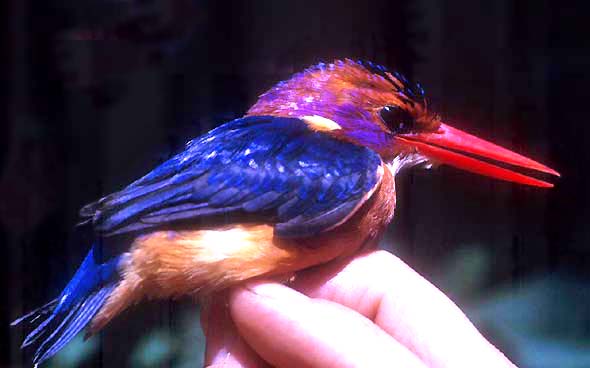
 The
Alcedininae, or River Kingfishers, are all small birds. They are the
most ancient of the three kingfisher lineages (Moyle 2006). Some
species in this group — in the genus Alcedo, like the very widespread Common Kingfisher A. atthis
— do fish regularly along streams and rivers. But many of the two dozen
species in this group are forest birds, although quite a few prefer the
edges of small wooded rivulets.
The
Alcedininae, or River Kingfishers, are all small birds. They are the
most ancient of the three kingfisher lineages (Moyle 2006). Some
species in this group — in the genus Alcedo, like the very widespread Common Kingfisher A. atthis
— do fish regularly along streams and rivers. But many of the two dozen
species in this group are forest birds, although quite a few prefer the
edges of small wooded rivulets. Woodall (2001) placed all 24 species in just two genera — Ceyx and Alcedo
— but these have not proved to be monophyletic groups. Marks &
Willard (2005) recognized at least 4 genera on molecular evidence.
Consider, for example, Madagascar Pygmy-Kingfisher
(right). This tiny beauty is only 7 inches (13 cm) long, and hunts for
frogs and insects from a low branch in the dense understory. Because of
its rufous color and bill shape, it had been thought to be linked to
dwarf kingfishers in southeast Asia [genus Ceyx] but genetically it is closer to the African species of dwarf kingfisher, which should be placed in the genus Corythornis.
These data suggest the certain behaviors and plumage types evolved
separately several times in the Alcedininae (Marks & Willard 2005,
Moyle et al. 2007).
Woodall (2001) placed all 24 species in just two genera — Ceyx and Alcedo
— but these have not proved to be monophyletic groups. Marks &
Willard (2005) recognized at least 4 genera on molecular evidence.
Consider, for example, Madagascar Pygmy-Kingfisher
(right). This tiny beauty is only 7 inches (13 cm) long, and hunts for
frogs and insects from a low branch in the dense understory. Because of
its rufous color and bill shape, it had been thought to be linked to
dwarf kingfishers in southeast Asia [genus Ceyx] but genetically it is closer to the African species of dwarf kingfisher, which should be placed in the genus Corythornis.
These data suggest the certain behaviors and plumage types evolved
separately several times in the Alcedininae (Marks & Willard 2005,
Moyle et al. 2007).  Seven
of the group have names like "pygmy-kingfisher" or "dwarf-kingfisher."
Almost all of these tiny kingfishers hunt fish and amphibians along
forested streams where dense thickets make viewing difficult. Despite
their bright colors, most of the alcedine kingfishers are quite hard to
see. The Blue-eared Kingfisher (left, in a video
capture by Rita Carratello) is usually just barely glimpsed as a jolt
of bright blue disappearing through the roots of riverside vegetation
in of s. Asia or the Greater Sundas.
Seven
of the group have names like "pygmy-kingfisher" or "dwarf-kingfisher."
Almost all of these tiny kingfishers hunt fish and amphibians along
forested streams where dense thickets make viewing difficult. Despite
their bright colors, most of the alcedine kingfishers are quite hard to
see. The Blue-eared Kingfisher (left, in a video
capture by Rita Carratello) is usually just barely glimpsed as a jolt
of bright blue disappearing through the roots of riverside vegetation
in of s. Asia or the Greater Sundas.  Some species of Ceyx kingfishers are endemics on islands in the western Pacific, including Silvery Kingfisher (right) of the Philippines. Other endemics occur on Sulawesi and the Bismark Archipelago, with one species — Azure Kingfisher Ceyx azurea — ranging as far as New Guinea and Australia. Some of them, including Silvery Kingfisher, are scare and local.
Some species of Ceyx kingfishers are endemics on islands in the western Pacific, including Silvery Kingfisher (right) of the Philippines. Other endemics occur on Sulawesi and the Bismark Archipelago, with one species — Azure Kingfisher Ceyx azurea — ranging as far as New Guinea and Australia. Some of them, including Silvery Kingfisher, are scare and local. 